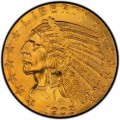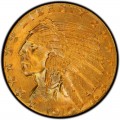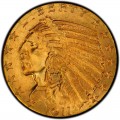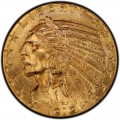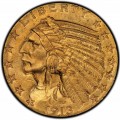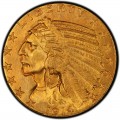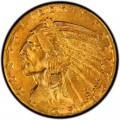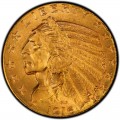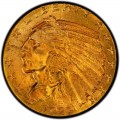- United States Coins
- Indian Head Half Eagles
Indian Head Half Eagles
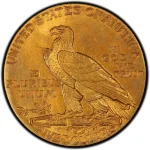 Indian Head $5.00 half eagle gold coins were made from 1908 through 1929 and are distinctive for being just one of two U.S. issues with an incuse design. The other coin, the similar Indian Head $2.50 quarter eagle gold coin, was produced for the same period of time and also designed by Bela Lyon Pratt. Indian Head half eagles were rather unpopular coins during their time, with complaints about the artistic level of the design and fears that the incuse strike on the coin would harbor bacteria and spread disease.
Indian Head $5.00 half eagle gold coins were made from 1908 through 1929 and are distinctive for being just one of two U.S. issues with an incuse design. The other coin, the similar Indian Head $2.50 quarter eagle gold coin, was produced for the same period of time and also designed by Bela Lyon Pratt. Indian Head half eagles were rather unpopular coins during their time, with complaints about the artistic level of the design and fears that the incuse strike on the coin would harbor bacteria and spread disease.
Today, the Indian Head half eagle is regarded as a classic gold coin, and the concerns about the hygiene of the incuse design have long since been unfounded. Many U.S. coin collectors love the Indian Head $5 half eagle as a pre-1933 gold type coin, though some financially well-heeled numismatists do attempt building a year set representing the series.
Practically any date of Indian Head Gold Half Eagle is worth between $980 and $1,015 in circulated grades, while the more common uncirculated grades start at $1,080 but quickly get into the thousands for key dates and high-grade Mint State specimens.
There are just 10 individual years during which the Indian Head half eagle was made during 1908 through 1929, though there are many more issues, counting the date-and-mintmark combinations. For the most part, Indian Head $5 gold coins are equally scarce in the circulated grades, with the exception of the 1909-O, 1911-D, 1913-S, and 1929 issues.
The 1929 Indian Head half eagle is the key date and also the only last-year issue for this series, meaning it is especially sought after by collectors. Most examples of this date were melted, making it extremely scarce today and boasting a value of $18,000 in Extremely Fine 40 grade. The 1909-O $5 gold coin is the next most-expensive issue starting at $7,750, with the 1911-D and 1913-S serving as semikeys with values of about $1,485 and $1,015, respectively. These three key dates soar into the tens of thousands of dollars for uncirculated specimens.
Below is a list of Indian Head Half Eagle info sheets for each year of issue. Each info sheet includes detailed pricing and mintage numbers for each variant.
-
{{#owner}}
-
{{#url}}
{{#avatarSrc}}
{{name}} {{/url}} {{^url}} {{#avatar}} {{& avatar}} {{/avatar}} {{name}} {{/url}} - {{/owner}} {{#created}}
- {{created}} {{/created}}

